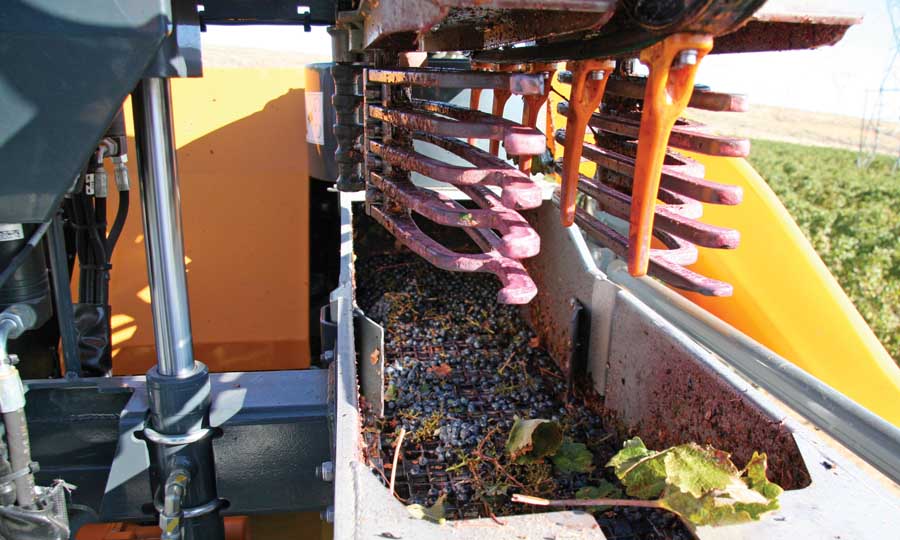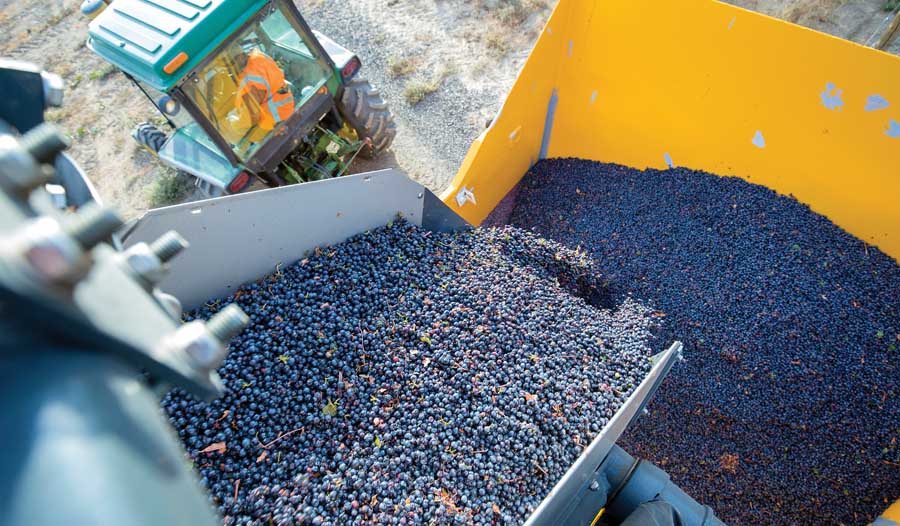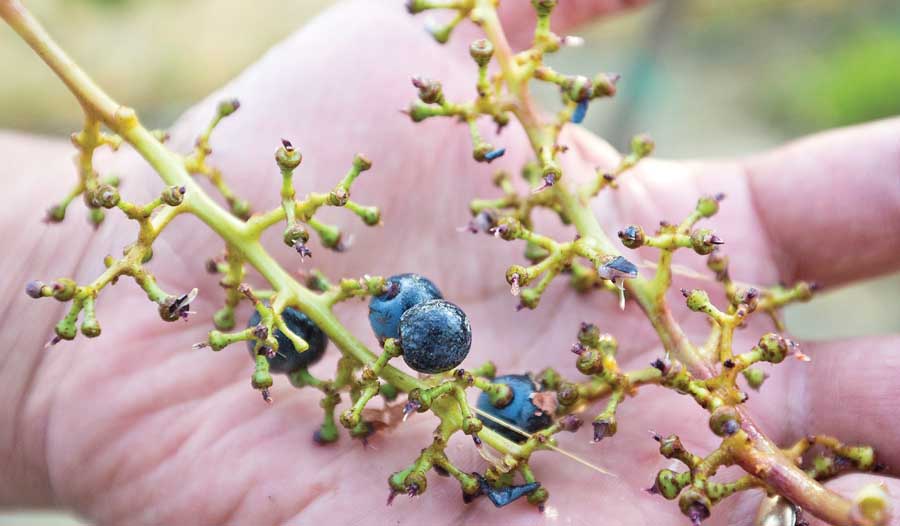
New mechanical grape harvesters have field sorting capability and can eliminate need for de-stemming, a task normally done at the winery. (TJ Mullinax/Good Fruit Grower)
Washington vineyards are moving closer to the day of total mechanization.
New devices use laser eyes, position sensors or potentiometers, and other technology to take vineyard tasks a step closer to the future.
Though hand picking is still preferred by winemakers for fruit destined for high-end wines, mechanization has a fit for production-based wine grapes and growers who face labor shortages.

The finger-like rods, located at the top of the harvester, break up small clusters and help release berries from stems.(Melissa Hansen/Good Fruit Grower)
Mechanical grape harvesters, with bow-like rods that knock berries off the cluster to leave the rachis behind on the vine, have been in use for decades. A drawback to mechanical harvesting has been inclusion of leaves, sticks, stems, and other MOG (material other than grapes) with the fruit.
The newest generation of grape harvesters can selectively de-stem and sort MOG in the field, eliminating need for additional sorting and de-stemming at the winery. Last year, Good Fruit Grower reported on new optical sorting technology being used by wineries on the crush pad to cull unwanted grapes, seeds, or stems (read “Optical sorters come to wineries,” November 2014).
Good Fruit Grower recently watched a state-of-the-art grape harvester in motion at Cold Creek Vineyard, one of Ste. Michelle Wine Estate’s oldest and most prestigious vineyards in Washington.
The harvester, the latest model from Pellenc, a French wine and grape equipment company, was wrapping up one of the earliest harvests and warmest growing seasons on record at Cold Creek.
Joe Cotta, manager of Cold Creek Vineyard near the Columbia River’s Hanford Reach, expected to finish grape harvest around October 10, two weeks earlier than normal.
He used up to 60 percent more water this summer compared to normal years because of the extreme heat, but is very happy with fruit quality. “We showed that we can be this hot and still have great quality fruit, which proves that it’s not just about temperatures, but you have to also have site and terroir.”
Selective harvesting
Selective grape harvesting has been an option since 2008 when Pellenc introduced the first grape-harvesting machine with MOG sorting and de-stemming abilities. Today, most major grape-harvester manufacturers, including OXBO, Gregoire, and New Holland, have selective harvest capabilities.
The latest Pellenc grape harvester Optimum model has several improvements from older models.
For example, the distance between the rollers that sort stems can be adjusted to sort out very small stems, there’s been a change in conveyor belt material and flow to be more gentle on fruit, and gains were made in fuel efficiency and ease of maintenance.

A spinning wheel kicks out leaves and other debris and sends it over the edge to the vineyard row below. (TJ Mullinax/Good Fruit Grower)
A computer touch-screen, instead of manual buttons, allows the operator to make picking adjustments on the go while inside the cab.
How clean is the fruit that’s delivered to the winery? The manufacturer claims 99.9 percent clean fruit by volume, according to Grant De Vries of Vine Tech Equipment in Prosser, the Pellenc dealer in Washington.
Large wine producers that grow their own grapes are typical users of selective harvesting machines. Around 15 selective harvesters are being used in Washington vineyards as well as many more traditional grape harvesters, which are used in juice grapes. About 75 to 80 percent of the state’s wine grape production is machine harvested.
“With the on-board de-stemming, growers actually lose a small amount of tonnage,” De Vries said. “Stems don’t weigh a lot, but you do lose a little, around 2 to 3 percent. If you have 500 tons or more, that all adds up. For growers who are paid by the ton, they have no reason to sort like that. That’s why selective harvesting is a hard sell to growers not connected to wineries.”
However, selective harvesting makes economic sense for growers converting from hand harvest to mechanical harvest for labor reasons, De Vries said.
Cold Creek
Cotta is impressed with Ste. Michelle Wine Estate’s new Optimum harvester.

About three tons of Cabernet Sauvignon grapes are transferred to a gondola for transport to a winery. Very little MOG is included in the load of fruit.(TJ Mullinax/Good Fruit Grower)
Hand picking is done on as much acreage at Cold Creek as possible, he says, but with more than 730 acres to harvest this past season, only grapes destined for the highest wine tier were hand picked. “We hand pick about 200 tons, but that’s only about 1 percent of the property’s total tonnage.”
The biggest benefit of the selective harvester is cleaner fruit, which translates into higher wine quality, said Cotta. “It’s helping improve the wine quality of our Indian Wells label. What drives our interest in mechanization is not so much economics but improvements to wine quality.”
This is the first season the Washington-based wine producer has used the Optimum model. Because Cotta shared the machine with the wine company’s vineyards in Patterson, it arrived after white varieties were already picked, so he only has experience with red grapes.
Winemakers still prefer fruit to be hand picked, because that’s what they know, but Cotta said Ste. Michelle Wine Estate winemakers are very pleased with fruit quality from the new harvester. “They told me, ‘If you have to machine pick something, make sure it’s with the new harvester.’”

Joe Cotta, manager of Cold Creek Vineyard, holds what he calls typical de-stemming by the new mechanical grape harvester. (TJ Mullinax/Good Fruit Grower)
After harvest, Ste. Michelle’s new machine, with a price tag of more than $400,000, will be transformed and used as an over-the-row, multi-function tractor. Various implements, such as sprayers, pre-pruners, and leaf removal devices, will be attached and used during the growing season. •
—Melissa Hansen






Leave A Comment